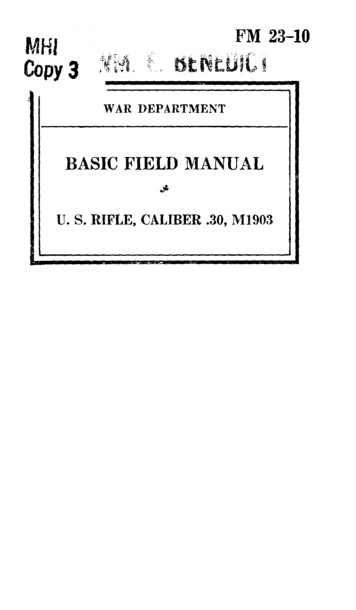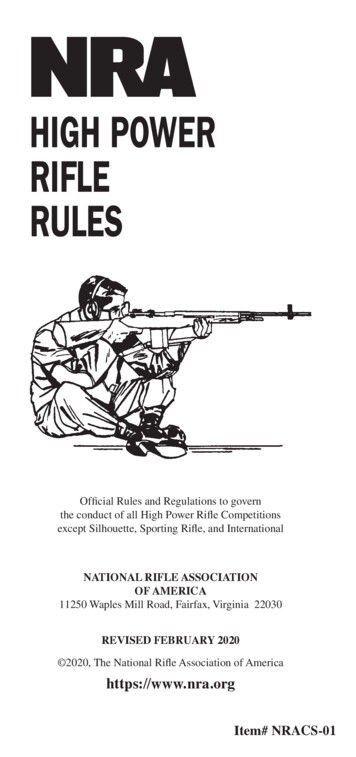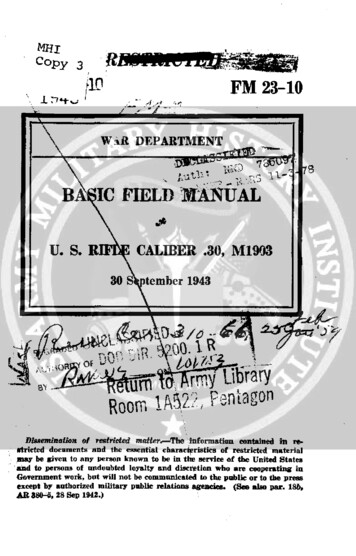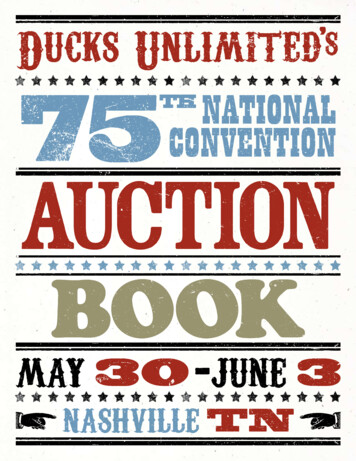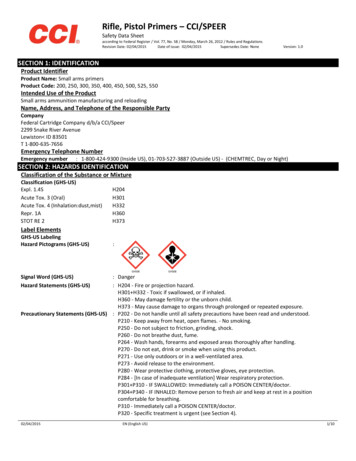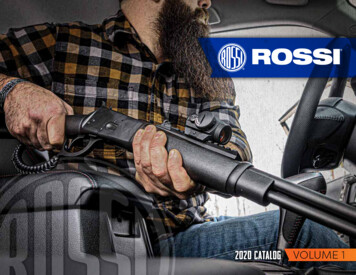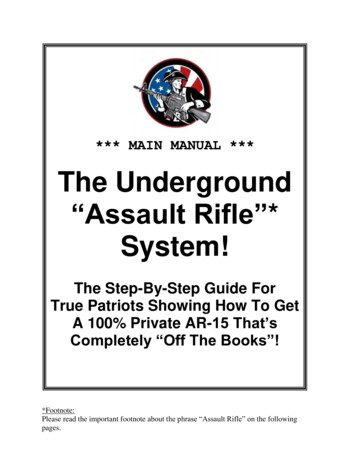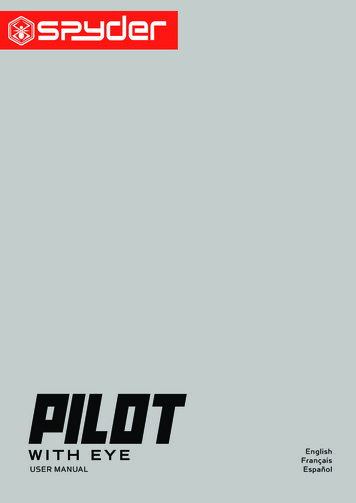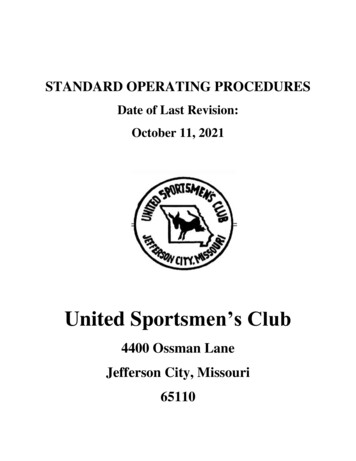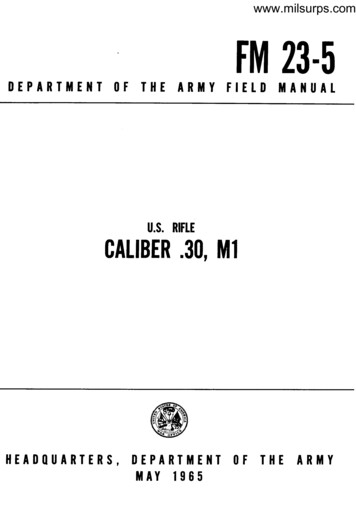
Transcription
ALU.S. RIFLECALIBER.30, MlHEADQUARTERS,DEPARTMENTMAY1965OFTHEARMY
www.milsurps.com*FM 22-5HEADQUARTERSDEPARTMENTOFTHEARMYWASHINGTON, D.C., I7 Huy 1965FIELD MANUALNo. 23-5IU.S. RIFLE, CALIBERCHAPTER RAINING ,OPERATION AND FUNCTIONINGSTOPPAGES AND IMMEDIATE ACTION -MAINTENANCE .AMMUNITION - -- - - - - --- REFERENCES*This manual supersedes FM 23-5,26 kphmberP-*I- 45-1112-1516-1920-2425,26PW3514192025261956, including Cl, 22 June 1960.1
www.milsurps.comCHAPTER1INTRODUCTION1. Purpose andScopea. This manual is a guide for commanders andinstructors in presenting instruction and trainingin the mechanical operation of the Ml rifle. Itincludes a detailed description of the rifle and itsgeneral characteristics; procedures for disassembly and assembly ; methods of loading; an explanation of functioning; a discussion of stoppages and immediate action; a description of theammunition ; and instructions on the care andcleaning of both the weapon and ammunition.The material presented is applicable, withoutmodification, to both nuclear and nonnuclearwarfare.b. Marksmanship training is covered in FM23-71.c. Users of this manual are encouraged to submit recommended changes or comments to improve the manual. Comments should be keyed tothe specific page, paragraph, and line of the textin which the change is recommended. Reasonsshould be provided for each comment to insureunderstanding and complete evaluation. Comments should be forwarded direct to the Commandant, U.S. Army Infantry School, Fort Benning, Ga.2. Importance of Mechanical TrainingThe rifle is the soldier’s basic weapon. It giveshim an individual and powerful capability forcombat. To get the most out of his individualcombat capability, the soldier must develop twoskills to an equal degree: he must be able to firehis weapon well enough to get hits on battlefieldtargets, and he must know enough about itsworking parts to keep them operating smoothlyso the rifle will not fail him. The soldier gets hisfiring skill on marksmanship training ranges andhe learns how to keep his rifle in firing conditionfrom the mechanical training that is outlined inthis manual.3. Descriptionof the RifleThe U.S. rifle caliber .30, Ml, (fig. 1) is anair-cooled, gas-operated, clip-fed, and semiautomatic shoulder weapon. This means that the aircools the barrel ; that the power to cock the rifleand chamber the succeeding round comes fromthe expanding gas of the round fired previously ;that it is loaded by inserting a metal clip (containing a maximum of eight rounds) into the receiver ; and that the rifle fires one round each timethe trigger is pulled.4. GeneralDataWeight :Complete with sling, eightround clip and cleaningequipment (approximate)Length :OverallSighta :FrontRear11% pounds.43inches.Fixed.Adjustable.One clickof elevation or windage movea the strikeof the bullet .7 centimeters at 26 meters.Trigger pull :MinimumMaximumAmmunitionMuzzle velocity (approximately)5% pounds.7% pound&See chapter 6.853 metera (2,SOOfeet )per second.Chamber pressure 50,000 poundspersquare inch.Maximum range 3,200 meters.Maximum effective range’ 460 meters.Maximum effective rate of flre * 16 to 24 rounds perminute.‘Maximum effective range ia the greatest dletance at which aweapon mag be expected to 5re accurately to inflict caeualtiee ordamage.*Althou h there is norescribed mnxlmum rate of fire, atrained ri Ifeman can 5re 1 B to 24 aimed rounds per minute.3
www.milsurps.comFigure 1.4U.8. rifle, caliber30, Ml.
www.milsurps.comCHAPTER 2MECHANICAL5.DisassemblyandAssemblya. The individual soldier is authorized to disassemble his rifle to the extent called f&d stripping.Table I, Disassembly Authorization (para.7)) shows the parts he is permitted to disassemble.This amount of disassembly is necessary for normal maintenance.b. The rifle should be disassembled and assembled only when maintenance is required or for instructional purposes. Repeated disassembly andassembly causes excessive wear of parts and soonmakes them unserviceable and reduces the accuracy of the weapon.c. The rifle has been designed so that it may betaken apart and put together easily. No force isneeded if it is disassembled and assembled correctly. The parts of one rifle, except the bolt,may be interchanged with those of another whennecessary; for safety reasons, bolta should neverbe interchanged except by maintenance supportpersonnel.d. As the rifle is disassembled, the parts shouldbe laid out on a clean surface, in the order of re-Figure 2.TRAININGmoval, from left to right. This makes assemblyeasier because the parts are assembled in the reverse order of disassembly. The names of t.herifle parts (nomenclature) should be taught alongwith disassembly and assembly to make futureinstruction on the rifle easier to understand.6.ClearingtheRifleThe first step in handling any weapon is toclear it. If the rifle is loaded, unload it as described in paragraph 13. The Ml rifle is clearwhen there is no ammunition in the chamber orreceiver, the bolt is locked to the rear, and thesafety is engaged. To clear the rifle, pull theoperating rod handle all the way to the rear, inspect the chamber and receiver to insure that norounds are present and push the safety to itslocked position (inside the trigger guard).7. Disassembl’yInto the ThreeMainGroupsa. The three main groups are the trigger housing group, the barrel and receiver group, and thestock group (fig. 2).The three m&n groupe.
www.milsurps.comb. To disassemble the rifle into the three maingroups, first insure that the weapon is clear andthen allow the bolt to go forward by depressingthe follower with the right thumb and allowingthe bolt to ride forwardover the followerassembly.c. Place the rifle butt against the left thigh,sights to the left. With the thumb and forefingerof the right hand, pull downward and outwardon the rear of the trigger guard. Swing the trigger guard out as far as it will go and lift out thetrigger housing group (fig. 3).Remove the followerby withdrawingrod and operatingthem to the right.rod springDo not sep-arate these parts.b. Using the tip of a dummy cartridge,the followerarm pin by pushingremoveit from the farside of the receiver toward the body(fig. 5).d. To separate the barrel and receiver from thestock lay the weapon on a flat surface with theWith the left hand,sights up, muzzle to the left.grasp the rear of the receiver and raise the rifle.With the right hand, give a downwardblow,grasping the small of the stock. This will separate the stock group from the barrel and roupa. Place the barrel and receiver group, with thebolt closed, on a flat surface with the sights down(insuring that the aperture is at its lowest position),muzzle pointingto the left.Holdingtherear of the receiver with the right hand, grasp thefollower rod with the thumb and forefinger ofthe left hand and disengage it from the followerarm by moving it toward the muzzle (fig. mbly AuthorizationOroups and partsSEPARATION :INTO THREE MAIN GROUPS ---- - - DISASSEMBLY:BARREL AND RECEIVERGROUPBolt assembly .Gas cylinder - - - - --Gas cylinder lock - -- --Clip latch -- - --Rear sight - - -Slide from follower .-- - - - - .Accelerator from operating rod catch assembly-- -- -Front sight --TRIGGER HOUSING GROUP . nel onlyX . .XRemove -----Remove ----Remove -RemoveRepairRepair .RemoveRepair -Repair air/Replace.Repair/Replace.Repair/Replace.
www.milsurps.comrod to the rear until the rear of the handle is directly under the forward edge of the windageknob. With an upward and outward movement,disengage the guide lug of the operating rodthrough its dismount notch on the receiver. Remove the operating rod (fig. 7).Figure 4.Removingthe followerspring.rod and operatingrodFigure 6.Figure5.Removingthe followerRemoving the Bullet guide, followeroperating rod catch assembly. 7n Pin.c. With the left hand, grasp the bullet guide,follower arm, and the operating rod catch assembly, and lift them out of the receiver together(fig. 6). Separate and arrange these parts fromleft to right in the following order : follower arm,operating rod catch assembly, and bullet guide.d. Reach down into the receiver and lift out thefollower assembly.e. Turn the barrel and receiver group over sothat the sights are up, muzzle pointing away fromyou. With the left hand, raise the rear of thereceiver. With the right hand, pull the operatingFigure7.Removingthe operatingrod.arm, and
www.milsurps.comCaution: The operating rod is bent intentionally so that it will not bind against theenlarged portion of the barrel. Do not attemptto straighten it.f. With the right hand, grasp the bolt by theoperating lug and slide it fully to the rear; thenslide it forward, lifting upward and outward tothe right front with a slight rotating motion toremove it.g. Using the screwdriver blade of the Ml0cleaning rod handle as shown in figure 8, unscrewand remove the gas cylinder lock screw.h. Unscrew and remove the gas cylinder lock.Loosen the gas cylinder by tapping lightly towardthe muzzle on the bayonet stud with a piece ofwood or similar soft object (fig. 9). Remove thegas cylinder, taking care not to burr or damagethe splines. Do not remoue or attempt to adjustthe frontsight.i. Remove the front handguard by sliding itforward over the muzzle. Do not attempt to remove the rear ha&guard.j. The parts of the barrel and receiver groupin their order of disassembly are shown in figure10.9.AssemblyoftheBarrelandReceiverGroupa. Replace the front handguard by sliding itover the muzzle and insure that it is seated in thefront band.b. Place the gas cylinder over the barrel, making sure the splines are alined with their grooves.Push the gas cylinder down as far as it will go.If tapping is necessary, use a piece of wood on thebayonet stud. Engage the threads of the gascylinder lock with those on the barrel and screwthe lock on by hand until it is finger tight (do notuse a tool). If the lock is not alined with the gascylinder, do not force it, but unscrew it until it isalined. Replace and tighten the gas cylinder lockscrew with the handle assembly of the Ml0 cleaning rod.c. To replace the bolt, hold it by the operatinglug and place the rear end of the bolt onto thebridge of the receiver. Rotate the bolt counterclockwise as far as necessary to permit the tangof the firing pin to clear the top of the bridge ofthe receiver. Guide the left locking lug of thebolt into its groove on the left side of the receiver.Lower the righk locking lug on its bearing surface and slide the bolt halfway to the rear.d. To replace the operating rod, hold the handle with the right hand and place the piston endinto the gas cylinder. Aline the operating rodso that the recess in the hump fits over the operating lug of the bolt. While applying pressuredownward and inward on the handle, pull the operating rod to the rear until the guide lug is engaged in its groove (fig. 11). Move the operatingrod forward until the bolt is closed.e. Turn the ,barrel and receiver group over sothat the sights are down and the muzzle is to theleft. Replace the follower assembly so that itsguide ribs fit into their grooves in the receiver.Make sure that the slide of the follower is downand that the square hole is to the rear (fig. 12).The slide will rest against the bolt.f. Replace the bullet bide so that its shouldersfit into their slots in the receiver and the hole inthe toe of the bullet guide is alined with the holesin the receiver (fig. 13).g. With the right hand, lift up the lower partof the bullet guide slightly. With the left hand,insert the rear arm of the operating rod catch assembly through &he clearance cut in the side ofthe bullet guide. Make sure that the rear arm isunderneath the front stud of the clip latch whichprojects into the receiver (fig. 14). Lower thebullet guide into place. Test for correct assemblyby pressing down on the front arms of the opera%ing rod catch assembly. It should move and youshould be able to feel the tension of the clip latchspring.h. Replace the follower arm by passing its rearstuds through the bullet guide and inserting theminto the guide grooves on the follower (fig. 15).Allow the wings of the follower arm to rest astridethe toe of the bullet guide. Aline the holes in theoperating rod catch assembly, follower arm, andbullet guide with those in the receiver and replacethe follower arm pin from the near side.i. Insert the loose end of the operating rodspring into the operating rod. Grasp the followerrod with the left hand, making sure that its humpis toward the barrel. Pull toward the muzzle,compressing the operating rod spring, and engagethe claws of the follower rod with the front studsof the follower arm (fig. 16). You may have toraise the follower assembly to do this,
www.milsurps.comFigure 8.771-952-2Remodlcgthe gaa c@hderlock acrew.9
www.milsurps.com10. Assembly of the Three Main Groupsa. Place the barrel and receiver group on aflat surface, sights down. Pick up the stock group. *i,*i: ,“’ 2:‘tr, v.m; 1) ?.,LI .‘*\p-” ‘Q’ *%and engage the U-shaped flange of the stock ferrule in the lower band, then lower the stock grouponto the barrel and receiver group (fig. 17).6. Unlatch and open the trigger guard. Keeping the base of the trigger housing group level,place it straight down into the receiver, makingsure that the locking lugs on the trigger guardenter their recesses in the receiver (fig. 18).Place the butt of the rifle on the left thigh withthe sights to the left. Close the trigger guardand latch it by striking it with the heel of theright hand. The trigger guard is latched whilethe rifle is in this position so that the rear sightwill not be damaged.11. Test for Correct AssemblyFigure109.Removingthe gas cylinder.Each time the rifle is disassembled and assembled it should be tested to make sure that it is puttogether properly. To do this, pull the operatingrod to its rearmost position. The bolt shouldstay open. Close the bolt and snap the safety toits locked position. Squeeze the trigger. Thehammer should not fall. Push the safety to itsunlocked position and squeeze the trigger. Thehammer should fall. This test is made to checkthe operation of the safety.
MBLYOPERATINGRODCATCH&-ASSEMBLYFigure 10.Parts of the barrel amd receivergroup L the order of di8a88mb.@.11
www.milsurps.comFigure 13.Figure 11.RepZucimg the operatdng rod.F&we 14.Figure la.12ReQtadng the bullet guide.RepZtadw the foZZoww wsmbZ%RepZacZng the operating rod catch aasembZg.
www.milsurps.comFigurecReplacingthe follower8P99Wrod and operatingReplacing the stock cm the bawelreceiver group.and‘dFigureFigure 16.17.18.Replacingthe triggerhoueinggroup.rod13
www.milsurps.comCHAPTER 3OPERATIONAND FUNCTIONING12. loading the Riflea. Single mum?.To load a single round, pullthe operating rod all the way to the rear. Whileholding the muzzle below the horizontal, place around in the chamber and seat it with the thumb.With a knife edge of the right hand against theoperating rod handle, force the operating rodslightly to the rear. Push down on the followerassembly with the right thumb and allow the boltto ride forward. Remove the thumb from the follower assembly and release the operating rod handle, allowing the operating rod to go all the wayforward.6. FuJ2 clip. To load a full clip, hold the rifleat the balance with the left hand and pull the operating rod handle all the way to the rear. Placethe butt of the rifle against the thigh or on theground. With the right hand, place a full clipon top of the follower assembly. Place the thumbon the center of the top round in the clip andpress the clip straight down into the receiver until it catches (fig. 19). Swing the right hand upand to the right to clear the bolt in its forwardmovement. Note that the operating rod is not heldto the rear during loading since there is no dangerof it going forward as long as pressure is main-Ftgure 19. Loading a run clip.14
www.milsurps.comtained on the top round in the clip. It may beto strike forward on the operating rodhandle with the heel of the right’hand to fullyclose and lock the bolt.c. Pa&fatty fdkd clip.To load a partiallyfilled clip, hold the rifle in the same manner prescribed for a full clip. With the operating rodall the way to the rear, place an empty clip intothe receiver. Place the first round into the clipand on the follower, to the left of the followerslide. Press the second round into the clip, exerting a downward, turning motion until theround snaps into place. Load the remainingrounds in the same manner (fig. 20). With theknife edge of the right hand against the operatingrod handle force the operating rod slightly to therear. Push down on the top round with the rightthumb, allowing the bolt to start the top roundforward. Remove the right hand and allow theoperating rod to go forward.necessary13. Unloading the Riflea. To unload a round from the chamber, support the rifle butt on the thigh or on the ground ;with the right hand grasp the operating rod handle and pull the operating rod slowly to the rear.At the same time, place the left hand, palm down,over the receiver to catch the round as it is ejected(fig. 21). This keeps the round from falling intothe dirt or away from your position.b. To unload a filled or partially filled clip, unload the round that is in the chamber as describedin a above. When the operating rod reaches itsrearmost position, hold it there. Place the palmof the left hand over the receiver and depress theclip latch with the left thumb, allowing the clipto be ejected up into the hand (fig. 22). Do notrelax the rearward pressure on the operating rodhandle until after the clip has been removed.6. Each time rounds are loaded into a clip, theclip should be checked for long rounds. If oneround extends beyond the others, it will be hardto load the clip into the rifle. The long roundshould be seated by removing the top round, pushing the long round into place and then replacingthe top round. Tapping the bullet against asolid surface to seat the long round may resultin the bullet being pushed back into its cartridgecase. This may damage the bullet or break theFigure20.Loadinga partiallyflUed dip.14. loading Rounds Into a Clipa. Insert eight rounds into the clip, holding theclip and rounds in the manner shown in figure 23.Start placing the rounds in from the lower left ofthe clip and make sure that each round is againstthe rear wall so that the inner rib of the clip engages the extracting groove of each round. Thetop round will then be on the right, making theclip easier for a right handed firer to load in therifle. For the same reason, clips are loaded thisway at arsenals.Figure81.Unloadinga roundlromthe chamber.
www.milsurps.comFigureW.Loadingrounda i&o a clip.bullet seal which could result in changes in theballistic performance of the round.15. Functioning of. the Riflea. The trigger must be pulled to fire each round.When the last round is fired, the empty clip isautomatically ejected and the bolt remains to therear.6. Each time a round is loaded and fired, manyparts inside the rifle work in a given order. Thisis known as the cycle of operation. This cycle16is similar in all small arms. A knowledge of whathappens inside the rifle during this cycle of operation will help the soldier understand the causeof and remedy for various stoppages.c. The cycle of operation is broken down intoeight steps. These steps are listed below, togetherwith a brief description of what actually occursinside the rifle during each step. Assume that afull or partially filled clip has been loaded intothe rifle and that the first round has been firedand the bolt is in its rearmost position (fig. 24).(1) Feeding. Feeding takes place. when ‘around is moved into the path of the bolt.This is done by the follower assemblyexerting an upward pressure on the bottom round in the clip. The follower assembly is continuously forced up by thepressure of the operating rod springthrough the follower rod and followerarm (fig. 24).(2) Charnbering. Chamber&g occurs whena round is moved into the chamber. Thistakes place as the bolt goes forward under pressure of the expanding operatingrod spring, picking up the top round inthe clip and driving it forward into thechamber (fig. 25). Chambering is complete when the extractor snaps into theextracting groove on the cartridge caseand the ejector is forced into the face ofthe bolt.(3) Loci&g. Locking is complete when thebolt is fully closed. This prevents theloss of gas pressure until the bullet hasleft the muzzle. The bolt is locked by therear camming surface in the recess in thehump of the operating rod, forcing theoperating lug of the bolt down. This engages the locking lugs on the bolt withtheir recesses in the receiver (fig. 26).(4) IG &ng. Firing occurs when the firingpin strikes the primer. As the triggeris pulled the trigger lugs are disengagedfrom the hammer hooks and the hammeris released. The hammer moves forwardunder the pressure of the hammer springand strikes the tang of the firing pm, driving the firing pin against the primer andfiring the round (fig. 27).(5) Unlocking. Unlocking occurs after thefiring of the round. As the bullet isforced through the barrel by the expand-
www.milsurps.coming gas, a small portion of the gas escapesthrough the gas port into the gas cylinder,forcing the operating rod to the rear (fig.28). The camming surface inside the recess in the hump of the operating rodforces the operating lug of the bolt upward, disengaging the locking lugs fromtheir IXXAXXWin the receiver. The bolt isthus unlocked and ready to be moved tothe rear (fig. 29).Extracting is pulling the(3) E&raoting.empty cartridge case from the chamber.The extractor, which is engaged with theextracting groove on the cartridge case,withdraws the empty case as the boltmoves to the rear (fig. 30).Figure 84. Po84Non of part8 when the bolt 48 tn it8 rearmost position.Figure 85.Chamber&g.Figure 26. Loclcing.Figure 87. Firing.
www.milsurps.comGAS CYLINDERGAS PORT JFigure 89.Unlocking.Figure 2’8. Action of the XEBOLTEMPTY(7)(8)JO. Extracting.mer is forced into the proper position forfiring the next round. This happens asthe bolt continues to the rear. The rearend of the bolt forces the hammer backand rides over it. The hammer is caughtby the sear if the trigger is still held tothe rear, but it is caught by the triggerlugs if trigger pressure has been released(fig. 31).Ejecting is throwing theEjecting.empty case from the rifle. As the boltmoves to the rear, withdrawing the casefrom the chamber, the round is held inplace by the chamber walls. When themouth of the empty case clears the chamber, it is ejected up and to the right bythe expanding ejector spring and ejector.Cocking. Cocking occurs when the ham-EMPTY CARTRIDGECASEmMOUTH OF MERLEJECTORLUGSFigure 31.CASECASE/7FigureCARTRIDGEEjectingand cocking.WALLS
www.milsurps.comCHAPTER 4STOPPAGESAND IMMEDIATE16. Stoppagesa. A stoppage is any unintentional interruptionin the cycle of operation.b. Most stoppages occur because of dirty, worn,or broken parts, and lack of lubrication. Therifleman must be taught to watch for these defects and take corrective action to eliminate thembefore they cause a stoppage. Some of the morecommon stoppages, with their usual causes andremedies, are shown in table II (para 19). Notethat the stoppages are classified according to thesteps of the cycle of operation.17. Immediate Actiona. Immediate action 2 the prompt action takenby the firer to reduce a stoppage.To apply im-ACTIONcaused by faulty ammunition, the lot numbershould be reported to ammunition supply personnel for inspection and determination of disposition.19. MalfunctionsA malfunction is a failure of the weapon tooperate satisfactorily. Some of the common malfunctions are discussed below.a. The clip may jump out on the seventh round.This is usually caused by a bent follower arm orbullet guide and can be corrected by replacingthem.b. The rifle may ‘fire in bursts of two or threerounds. This is due to the sear being broken,mediats action, pull the operating rod handle allthe way to the rear with the right hand, paZmup, then release it. The right hand should be heldin the manner shown in figure 32 so it will not beinjured in the event of a hangfire. Next, aim therifle and try to fire it.b. If a rifleman is taught to apply immediateaction quickly and properly when his rifle fails tofire, he will be able to reduce most stoppages(table II).18. Misfire, Hangfire, and Cookoffa. Hang&es and misfires rarely occur. Normally, the firer will instinctively apply immediateaction which in most instances reduces the stoppage even when caused by a hangfire or misfire.b. Misfires are caused by one of three factorsthe firer, the weapon malfunctioning (due to excessive dirt, etc.), or faulty ammunition. Whenthere has been an excessive number of misfiresFigure52.Applyingimmediatea&on.19
www.milsurps.comworn, or remaining in an open position. It canbe correctedby replacing the trigger assembly.c. The safety may release when pressure is applied to the trigger. This can be caused by -abroken safety or by the trigger stop on the safetybeing worn. It can be corrected by replacing thesafety.Table II.BtoppageaFailure to feedFailure to chamber- -Failure to lockFailure to fireFailure to unlockFailure to extractFailure to eject -- -Failure to cock -20d. Operating parts which fail to move fully tothe rear (short recoil) are caused by(1) Valve leak in gas cylinder lock screw.(Valve not fullySeated.)Defectiveoperating rod spring.(2)Undersizedpiston. (Caused by the use(3)of abrasives when cleaning the piston.)Stoppages, Their Cause8 and RemediesC!W&lLack of lubrication of operating partaDefective or worn parts ,ShortrecoilLack of lubrication of operating partsDirty chamber- Defective ammunition -Lack of lubrication of operating partaDirty chamber Dirty locking recesses .Weak operating rod springDefective ammunitionDefective firing pinDefective trigger housing group -Dirty chamberLack of lubrication of operating par&InsuflicientgasDirty chamberDirty ammunitionBroken extractor -Broken ejector or springShort recoilDefective trigger housing groupShort recoilIRemedyClean and lubricate parts (fig. 33).Replace parts.See paragraph 19d.Clean and lubricate parts.Clean chamber.Replace ammunition.Clean and lubricate parts.Clean chamber.Clean receasea.Replace spring.Replace ammunition.Replace firing pin.Repair trigger housing group.Clean chamber.Clean and lubricate parts.Tighten gas cylinder lock screw.Clean or replace worn parts.Clean chamber.Replace ammunition.Replace extractor.Replace ejector or spring.See paragraph 19d.Repair trigger housing group.See paragraph 19d.
www.milsurps.comCHAPTER5MAINTENANCE20. GeneralMaintenance includes all measures taken to keepthe rifle in operating condition. This includesnormal cleaning, inspection for defective parts, repair, and lubrication.21. Cleaning Materials,Equipmenta. Cleaninalubricants,andYatemX.9.BOG cleaner (cleaning compound solvent(CR) ) is used primarily for cleaning thebore; however, it may be used on all metalparts for a temporary (l-day) protectionfrom rust.(2) Hot, soapy water or boiling water is nosubstitute for bore cleaner and wiZZonlybe uaea?w&n bore cleaner isnot available.Drycleaningsolvent is used for cleaning(3)rifles which are coated with grease, oil,or corrosion-preventive compounds.(4) Stubborn carbon deposits are removed bysoaking in carbon removing compound(PCIII-A)and brushing. This processmust be followed by the use of drycleaning solvent.(1)(4) Rifle grease should be applied to thoseworking surfaces shown in figure 33.c. Equipment.A complete set of maintenanceequipment (figs. 34 and 35) is stored in the stocksof the Ml and MlC riflles and consists of(1) Ml0 cleaning rod (4 sections with handle and plastic buffer) .Small arms bore cleaning brush.Lubricant case.(4) Chamber cleaning brush.’(5) Cleaning rod case.132;22. Cleaning the Riflea. The rifle must be cleaned after it has beenfired because firing produces primer fouling,powder ashes, carbon, and metal fouling. TheCaution: Individual protective measures must be taken when using compound PCIII-A.b. Lubricants.(1) Lubricating oil, general purpose (PLspecial) is used for lubricating the rifleat normal temperatures.(2) Lubricating oil, weapons (LAW) is usedfor low temperatures (below 0’).(3) OE 10 engine oil may be used as a fieldexpedient under combat conditions whenthe oils prescribed in (1) and (2) abovecannot be obtained.However, theweapon should be cleaned and lubricatedwith the proper lubricants as soon aspossible.Figure 33. Point.vto apply rijee grease.* Insure the Ml chamber brush is used. The Ml4 rltle chamberbrush 1s #-inch shorter and 111 not clean the Ml chamber.21
www.milsurps.comM3CLEANINGRODCHAMBERBRUSHOILER& ER34.RODCleawing equipment.FABRIC CASE (HOLDS:R
follower arm, and the operating rod catch assem- bly, and lift them out of the receiver together (fig. 6). Separate and arrange these parts from left to right in the following order : follower arm, operating rod catch assembly, and bullet guide. d. Reach down into the receiver and lift out the follower assembly. e.
